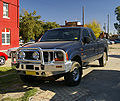2004 Ford F250 Diesel Supplement 2nd Printing - Page 43
2004 Ford F250 Manual
Page 43 highlights
Maintenance and Specifications REPLACING THE AIR FILTER ELEMENT When replacing the air filter element, use the Motorcraft air filter element listed. Refer to the Motorcraft part numbers chart in this section. Note: Do not start your engine with the air cleaner removed and do not remove it while the engine is running. Failure to use the correct air filter element may result in severe engine damage. 1. Remove the air filter element from the housing, taking care to prevent dirt from falling into the engine air intake. 2. Clean the air filter housing and cover to ensure good sealing. 3. Install a new air filter element. Be careful not to crimp the filter edges between the air filter housing and cover. This could cause damage to the air filter element and possible severe damage to the engine. When servicing the air filter, always be sure that the auxiliary hose is not kinked or obstructed. Failure to do so may result in severe engine damage when driving through deep water and/or encountering unusually heavy precipitation conditions. ENGINE COOLANT Checking engine coolant The concentration and level of engine coolant should be checked at the mileage intervals listed in the Scheduled Maintenance Guide. The coolant concentration should be maintained at 50/50 coolant and distilled water, which equates to a freeze point of -36° C (-34° F). Coolant concentration testing is possible with a hydrometer or antifreeze tester (such as the Rotunda Battery and Antifreeze Tester, 014-R1060). The level of coolant should be maintained at the "cold full" of "cold fill range" level in the coolant reservoir. If the level falls below, add coolant per the instructions in the Adding engine coolant section of this supplement. Your vehicle was factory-filled with a 50/50 engine coolant and water concentration. If the concentration of coolant falls below 40% or above 60%, the engine parts could become damaged or not work properly. A 50-50 mixture of coolant and water provides the following: • Freeze protection down to -36° C (-34° F). • Boiling protection up to 129° C (265° F). • Protection against rust and other forms of corrosion. 43
















